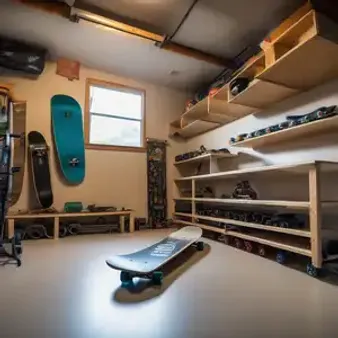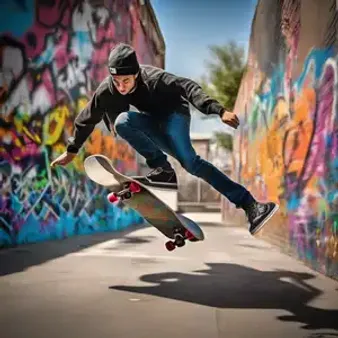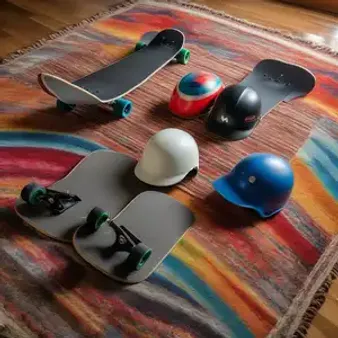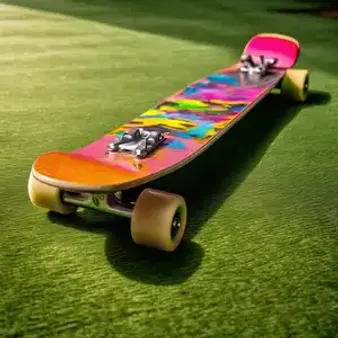Table of Contents
Have you ever wanted to learn how to skateboard at home? With a little creativity and the right guidance, you can transform your house into a skateboarding haven. At kizworld, we're passionate about helping you embrace new hobbies, and skateboarding at home is a fantastic way to have fun, stay active, and express yourself. So grab your board, and let's get started!
Topic | Key Points |
|---|---|
Setting Up | - Find a spacious area free of obstacles. - Consider using ramps or rails. - Ensure good lighting and ventilation. |
Mastering Tricks | - Start with basic tricks like ollies and shove-its. - Practice consistently and gradually progress. - Watch tutorials and learn from experienced skaters. |
Staying Safe | - Wear protective gear like a helmet, knee pads, and elbow pads. - Warm up before skateboarding and stretch afterwards. - Be mindful of your surroundings and skate within your limits. |
Beginners | - Choose a beginner-friendly skateboard. - Start with balance and control exercises. - Seek guidance from experienced skaters or online tutorials. |
Setting Up Your Skateboard at Home
Turning your home into a skater's paradise begins with finding the right space. You'll need a decent-sized area, free of furniture, breakables, and anything you wouldn't want to crash into. Think of it like choosing your own personal skatepark, but indoors! A garage, basement, or even a spacious hallway can work. Remember, the more space you have, the more creative you can get with your skateboarding maneuvers.
Now, let's talk about obstacles. I remember when I first started skateboarding at home, I used whatever I could find – stacks of books became ramps, old planks of wood turned into grind rails. It was a DIY skatepark in my own backyard! You can do the same, using household items to create your own unique obstacles. Just make sure they're sturdy and safe. You can also purchase ramps or rails specifically designed for skateboarding at home, if you're feeling fancy.
DIY Obstacle | Material |
|---|---|
Mini Ramp | Plywood, 2x4s |
Grind Rail | PVC pipe, wood |
Manual Pad | Wood, cinder blocks |
Don't forget about lighting and ventilation! Good lighting is essential so you can see clearly while practicing your tricks. If you're skating inside, make sure there's proper ventilation to keep the air fresh. You don't want to be gasping for air while trying to land a kickflip! Speaking of kickflips, if you're looking to master this trick, check out our guide on how to do a kickflip. It's packed with tips and tricks to help you nail it. Remember, setting up your skateboard at home is all about creating a space that's fun, safe, and inspiring. So get creative, unleash your inner skater, and let the good times roll!
Setting Up Your Skateboard at Home
Mastering Skateboard Tricks at Home
Now comes the fun part: tricks! Start with the basics, like the ollie. It's the foundation for so many other tricks. Imagine jumping with your board – that's basically what an ollie is! Once you've got that down, you can try a shove-it. It's like spinning your board 180 degrees under your feet. Feeling brave? Learn how to do a kickflip, where your board does a full flip in the air. It's like magic, but on a skateboard! Remember, practice makes perfect. Don't be discouraged if you don't get it right away. Check out our guide on how to do a kickflip for some helpful tips. You'll be landing these tricks in no time!
Mastering Skateboard Tricks at Home
Staying Safe While Skateboarding at Home
Safety first! It's easy to get caught up in the excitement of skateboarding at home, but remember, it's important to protect yourself. Imagine you're a knight getting ready for battle – you wouldn't go into a fight without your armor, right? Well, in skateboarding, your armor is your safety gear. Always wear a helmet – it's like a shield for your head! Knee pads and elbow pads are like armor for your joints, protecting you from bumps and bruises. Trust me, I've learned the hard way – a little padding can go a long way!
Gearing Up for Safety
Before you even step on your board, take a few minutes to warm up. Stretching is like giving your muscles a pep talk, getting them ready for action. Think of it like this – you wouldn't run a marathon without stretching first, would you? Skateboarding is no different! It's also a good idea to cool down after your session, giving your muscles a chance to relax and recover. Check out our guide on how to train like a skateboarder for some helpful stretches. And remember, always be aware of your surroundings. Make sure there's nothing in your way – no toys, furniture, or unsuspecting pets! It's like setting the stage for an awesome performance – you want a clear and safe space to show off your skills.
Skate Smart, Skate Safe
Skateboarding is all about pushing your limits and trying new things, but it's also important to know your limits. Don't try anything too crazy or dangerous, especially when you're first starting out. It's like learning to ride a bike – you wouldn't go jumping off ramps on your first try, would you? Start with the basics, get comfortable, and gradually work your way up to more challenging tricks. And if you're ever unsure about something, don't be afraid to ask for help. There are tons of resources available, like online tutorials, skateboarding communities, and even experienced skaters in your area who are happy to share their knowledge.
Safety Tip | Why It Matters |
|---|---|
Wear a Helmet | Protects your head from impacts |
Use Knee and Elbow Pads | Shields your joints from bumps and bruises |
Warm Up and Cool Down | Prepares your muscles for activity and helps them recover |
Be Aware of Your Surroundings | Ensures a clear and safe space for skateboarding |
Know Your Limits | Prevents injuries by avoiding overly challenging tricks |
Ask for Help When Needed | Provides guidance and support from experienced skaters |
Staying Safe While Skateboarding at Home
Skateboard at Home for Beginners
So, you're new to skateboarding and want to learn at home? Awesome! It's like learning to ride a bike, but way cooler. First things first, you'll need a beginner-friendly skateboard. Think of it as your trusty steed, ready to take you on an epic skateboarding adventure! You can find some awesome boards at online skate shops or local skate shops. Check out our guide on choosing the right skateboard to find the perfect one for you. Once you've got your board, it's all about balance and control.
Finding Your Balance
Imagine balancing on a tightrope, but with wheels! It might feel wobbly at first, but that's totally normal. Start by practicing on a soft surface, like grass or carpet. It's like having a safety net while you're learning the ropes. Once you feel more confident, you can move to a harder surface, like concrete. Remember, skateboarding is all about having fun, so don't be afraid to fall – it's part of the learning process!
Skill | How to Practice |
|---|---|
Balance | Stand on your board on a soft surface, shifting your weight and finding your center of gravity. |
Control | Practice pushing off and rolling on a flat surface, getting a feel for how your board moves. |
Now, let's talk about pushing off. It's like giving your skateboard a little kick-start, sending it rolling into action! Place your front foot on the board, just behind the front trucks. Use your back foot to push off the ground, propelling yourself forward. As you gain momentum, place your back foot on the board, near the back trucks. Think of it as a graceful dance between your feet and your board, working together in perfect harmony. If you're curious about how skateboarding can help you stay fit, check out our guide on the benefits of skateboarding for fitness.
Mastering the Basics
Once you're comfortable pushing off and rolling, you can start practicing turning. It's like steering a ship, but with your feet! To turn, lean in the direction you want to go. Shift your weight to your heels to turn right, and to your toes to turn left. It's all about finding the sweet spot, that perfect balance between leaning and steering. Remember, practice makes perfect, so keep rolling and keep turning until it feels like second nature. If you're interested in learning some cool skateboarding tricks, check out our guide on how to do an ollie. It's a classic skateboarding trick that's sure to impress your friends!
- Practice makes perfect – the more you skateboard, the better you'll get.
- Don't be afraid to fall – it's part of the learning process!
- Have fun – skateboarding is all about enjoying the ride!
Skateboard at Home for Beginners
Final Thought
Skateboarding at home is a rewarding experience that combines fun, fitness, and creativity. Whether you're a beginner or an experienced skater, there's always something new to learn and enjoy. So embrace the challenge, stay safe, and most importantly, have fun riding your skateboard in the comfort of your own home!